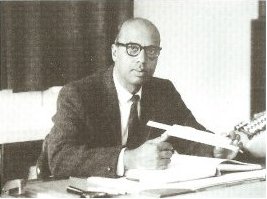
The Paris Observatory, a research institution of the Paris Sciences et Lettres University, is the foremost astronomical observatory of France, and one of the largest astronomical centers in the world. Its historic building is on the Left Bank of the Seine in central Paris, but most of the staff work on a satellite campus in Meudon, a suburb southwest of Paris.

Andrew Graham, born in Irvinestown County Fermanagh, Ireland, was an Irish astronomer, orbit computer and discoverer of the asteroid 9 Metis.

Benjamin Apthorp Gould was a pioneering American astronomer. He is noted for creating the Astronomical Journal, discovering the Gould Belt, and for founding of the Argentine National Observatory and the Argentine National Weather Service.

The Indian Institute of Astrophysics (IIA), with its headquarters in Bengaluru, is an autonomous research institute wholly funded by the Department of Science and Technology, Government of India. IIA conducts research primarily in the areas of astronomy, astrophysics and related fields.

The Kodaikanal Solar Observatory is a solar observatory owned and operated by the Indian Institute of Astrophysics. It is on the southern tip of the Palani Hills 4 kilometres (2.5 mi) from Kodaikanal.

Michael Topping (1747–1796) was the Chief Marine Surveyor of Fort St. George in Chennai responsible for founding the oldest modern technical school outside Europe. The Survey School was completed on 17 May 1794, with an initial intake of eight students. In 1858 it became the Civil Engineering School and the College of Engineering in 1861.

John Goldingham was the first official astronomer of the Madras Observatory, appointed in 1802. Goldingham was also an architect and surveyor who headed the Madras Survey School which later grew into the Guindy Engineering College and then Anna University. Born in London in 1767, Goldingham was first in the service of William Petrie at his private observatory and then hired by astronomer-sailor Michael Topping as his assistant in 1788.

William Petrie was a British officer of the East India Company in Chennai during the 1780s, and was Governor of Prince of Wales Island from 1812 to 1816. An amateur astronomer, Petrie helped found the first modern observatory outside Europe, the Madras Observatory.

Manali Kallat Vainu Bappu was an Indian astronomer and president of the International Astronomical Union. Bappu helped to establish several astronomical institutions in India, including the Vainu Bappu Observatory which is named after him, and he also contributed to the establishment of the modern Indian Institute of Astrophysics. In 1957, he discovered the Wilson–Bappu effect jointly with American astronomer Olin Chaddock Wilson.

The Bordeaux Observatory is an astronomical observatory affiliated with the University of Bordeaux. Built in Floirac, France in 1893 its lenses were focused between +11 and +17 degrees declination. Until 1970 it had taken over 4,000 photographic plates. Bordeaux Observatory is home to a large collection of instruments and archives from well over a century of astronomical activities. Until the 2016 it was actively used until the institution moved to a new location at the University. In the French language the name is Observatoire de Bordeaux.

NizamiaObservatoryy is an optical observatory built by Nawab Zafar Jung Bahadur member of the House of Paigah and Amir of the Khurshid Jahi estate and established by Mahbub Ali Khan, Asaf Jah VI - the 6th Nizam of Kingdom of Hyderabad in 1901. It participated in the Carte du Ciel making 463,542 observations. It boasted of an 8" Cooke Astrograph and a 15" Grubb refractor telescope.
X/1872 X1, occasionally referred to as "Pogson's Comet", was a probable cometary astronomical object seen from Madras on December 3 and 4, 1872, by astronomer N. R. Pogson.

Chinthamani Ragoonatha Chary was an Indian astronomer who worked at the Madras Observatory along with N.R. Pogson. He was the first Indian Fellow of the Royal Astronomical Society and is known for his studies of variable stars and the discovery of R Reticuli in 1867.

Norman Robert Pogson, CIE was an English astronomer who worked in India at the Madras observatory. He discovered several minor planets and made observations on comets. He introduced a mathematical scale of stellar magnitudes with the ratio of two successive magnitudes being the fifth root of one hundred (~2.512) and referred to as Pogson's ratio.
Isis Pogson,, was a British astronomer and meteorologist who was one of the first women to be elected as a fellow of the Royal Astronomical Society.

Jantar Mantar or Vedh Shala is located in the holy city of New Ujjain. It is an observatory built by Maharaja Jai Singh II in 1725 which consists of 13 architectural astronomy instruments. The observatory is one of the five observatories built by Maharaja Jai Singh II when he was governor of Ujjain.

Thomas Glanville Taylor was an English astronomer who worked extensively at the Madras Observatory and produced the Madras Catalogue of Stars from around 1831 to 1839.
Professor Charles Michie Smith CIE FRSE FRAS was a Scottish astronomer. He founded the Kodaikanal Solar Observatory in the mountains of south India and served as its first director.





















